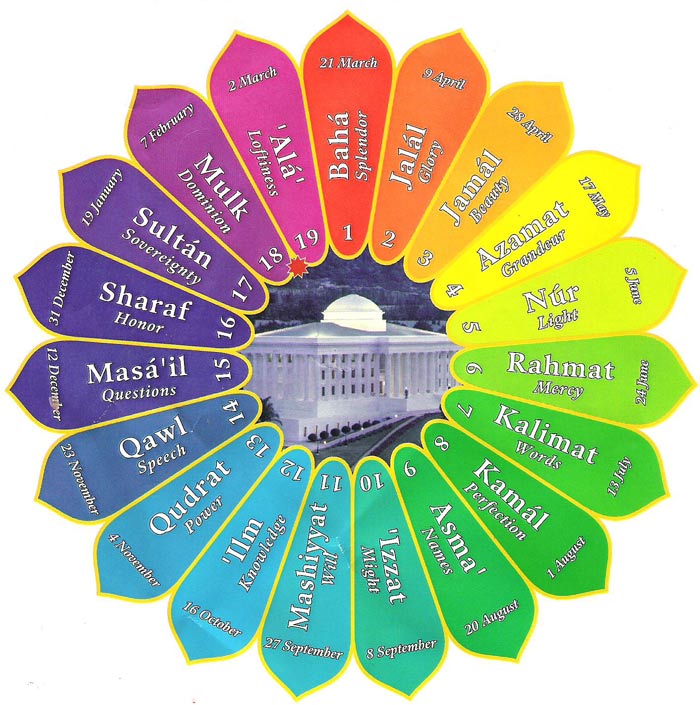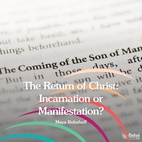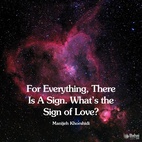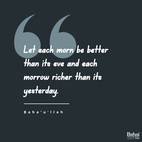The views expressed in our content reflect individual perspectives and do not represent the authoritative views of the Baha'i Faith.
The adoption of a new calendar in each dispensation is a symbol of the power of Divine Revelation to reshape human perception of material, social, and spiritual reality. Through it, sacred moments are distinguished, humanity’s place in time and space reimagined, and the rhythm of life recast. – The Universal House of Justice, Letter to the Baha’i World, 10 July 2014.
Every new Faith introduces its own new calendar, the Baha’i Faith included. A new calendar symbolizes the new era and the new teachings each religion brings to humanity.
Today in the world, we have two calendars in wide use across many nations and cultures: the Gregorian calendar, based on the solar year and typically known as the Western or Christian calendar; and the lunar-based Islamic calendar. The Islamic calendar, initially set forth in 638 A.D. by the Caliph Umar, has been in use the longest. The Gregorian calendar, brought into being by Pope Gregory XIII in 1582, has become the world’s most-used and widespread calendar.
The Baha’i calendar—also known as the Badi Calendar—unifies those two approaches with a lunisolar approach, which accommodates lunar calculations but bases its dates and months on a solar year of 365 days. One of the ways that unique approach manifests itself, in the celebration of the birthdays of both the Bab and Baha’u’llah—the founders of the Babi and Baha’i Faiths—begins for the first time today.
Among the most joyous days celebrated by Baha’is around the world, the “Twin Holy Days” mark the birthday of Baha’u’llah, the prophet and founder of the Baha’i Faith; and the birthday of the Bab, the forerunner of Baha’u’llah and the founder of the Babi Faith.
Baha’u’llah, in his Most Holy Book, ordains the celebration of a feast on each of these days, which makes them second in importance in the Baha’i calendar to the two “Most Great Festivals”—which commemorate the Declaration of Baha’u’llah in the garden of Ridvan (1863) and the Declaration of the Bab in Shiraz (1844).
Why are these Holy Days “twins?” Because, according to the Muslim calendar on which they were first recorded, the birthdays of the Bab and of Baha’u’llah fall on successive days—on the first day of the month of Muharram and on the second day of that same month, respectively. In the Most Holy Book, Baha’u’llah wrote:
All Feasts have attained their consummation in the two Most Great Festivals, and in the two other Festivals that fall on the twin days… Thus hath it been decreed by Him Who is the Ordainer, the Omnisicient. – p. 59.
In Iran, and in the Muslim countries of the East, including the Holy Land at the World Center of the Baha’i Faith in Haifa, Israel, Baha’is have traditionally observed those Holy Days in accordance with the Muslim calendar, and celebrated them together on consecutive days, counting them as one two-day festival. Baha’u’llah himself observed them this way.
In the Muslim lunar calendar, however, the Twin Holy Days move every year, because each new month begins with the appearance of a new moon. In relationship to the solar calendar, the Muslim calendar “loses” about eleven days every year—since twelve lunar cycles amount to approximately 354 days, which falls short of a full solar cycle.
Baha’u’llah was two years older than the Bab and so, on the Western solar calendar, their birthdays fall about three weeks apart. Therefore, Baha’u’llah’s birthday (2 Muharram of the year 1233 A.H.)—fell on 12 November 1817 A.D., while the Bab’s birthday (1 Muharram of 1235 A.H.)—fell on 20 October 1819.
In the United States and in Western countries, Baha’is have always observed the two birthdays on November 12 and October 20, the historical dates fixed for these days on the solar calendar. But this year, 2015, marks a significant change in that practice. Baha’is all over the world, including the Western countries, will now begin celebrating these joyous holy days according to a new, unique melding of the solar and the lunar calendars. Instead of relying solely on either calendar, Baha’is will celebrate the Twin Holy Days eight lunar months from the Baha’i New Year, which occurs on the vernal equinox of the solar year, usually March 21.
This year, the Twin Holy Days fall on November 13 and 14, and next year they’ll fall on November 1 and 2. Those Holy Days, according to the Universal House of Justice, the democratically-elected global administrative body of the Baha’i Faith, will now occur on adjacent dates that shift annually during the months of October or November each year:
We have decided that they will now be observed on the first and the second day following the occurrence of the eighth new moon after Naw-Rúz (the Baha’i New Year, March 21), as determined in advance by astronomical tables using Ṭihrán [Iran, the birthplace of Baha’u’llah] as the point of reference. This will result in the observance of the Twin Birthdays moving, year to year… from mid-October to mid-November according to the Gregorian calendar. – The Universal House of Justice, Letter to the Baha’i World, 10 July 2014.
For the very first time since the Baha’is began celebrating these Twin Holy Days in the middle of the 19th Century, Baha’is and their friends will observe a single, unified, globally-consistent celebration, beginning today. Just as the Baha’i teachings reconcile and unite the religions, so too do they unite and reconcile the world’s calendars.
When Baha’is celebrate these happy occasions, everyone is invited. At the worldwide Baha’i gatherings celebrating the birth of the Bab today, and the birth of Baha’u’llah tomorrow, happiness and good cheer will prevail. Music will play, friends will come together, children will laugh and warm fellowship will fill the air. Refreshments will definitely be served! The Twin Holy Days signal a joyful, celebratory season of the Baha’i year, when the Baha’i community comes together to commemorate the advent of the two prophets of God, the Bab and Baha’u’llah, the twin founders of their Faith, and to hail the beginning of a new era in human history.
Next: One Worldwide Celebration: The Baha’i Twin Holy Days
This article was adapted for BahaiTeachings.org, with the publisher’s permission, from the Kalimat Press book Twin Holy Days.


















Comments
Sign in or create an account
Continue with Facebookor